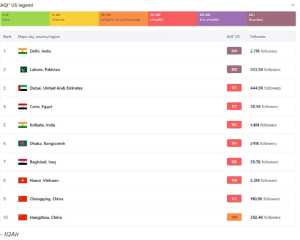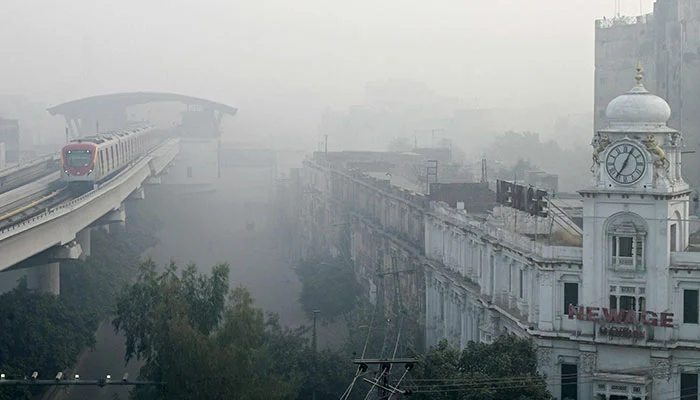On Monday, Lahore was ranked as the second most polluted city in the world, recording an Air Quality Index (AQI) of 382 as thick smog continues to shroud the Punjab capital despite measures to curb pollution.

According to data from IQAir, a Swiss air quality monitoring organization, Lahore’s AQI soared to an “unprecedented” 1,194 on Sunday, far surpassing the “dangerous” threshold of 300. The concentration of PM2.5 pollutants—fine particulate matter that poses significant health risks—was measured at 266 around 9:30 a.m., which is 53.2 times higher than the World Health Organization’s (WHO) acceptable level.
Read more: Punjab Police Rescue Imran Khan’s Lawyer, Intezar Hussain Panjutha
The severe pollution levels have prompted authorities to take emergency actions, including closing primary schools for a week and implementing work-from-home mandates. Additionally, the government has urged parents to ensure children wear masks, stay indoors, keep windows and doors shut, and limit non-essential travel. Measures such as a ban on three-wheeled rickshaws and restrictions on construction in certain areas have also been put in place, with warnings of permanent factory and construction site closures for non-compliance.
While Lahore struggles with “hazardous” air quality, other cities in Punjab, including Faisalabad, are also facing worsening pollution, with a thick blanket of smog spreading across the region.
Read more: Harris pledges to ‘do everything in my power to end the war in Gaza’ if elected US president
The Punjab government is considering diplomatic action with India, whose capital, New Delhi, topped global pollution levels on Monday with an AQI of 393. An Environmental Protection Department spokesperson pointed to smoke-laden air from India as a contributing factor to Lahore’s smog levels, and weather forecasts indicate that wind patterns are unlikely to change in the next six days.
Senior Punjab Minister Marriyum Aurangzeb described the situation as “unexpected” in a press conference, attributing it partly to cross-border pollution and stressing the need for dialogue with India. She said the provincial government would request the Ministry of Foreign Affairs to engage New Delhi through diplomatic channels.
The smog crisis, similar to that in New Delhi, tends to worsen in cooler months due to temperature inversions that trap pollutants near the ground. Last week, India called for regional cooperation in South Asia to address air pollution, though no formal discussions have been initiated.
The WHO warns that prolonged exposure to such toxic air can lead to severe health issues, including strokes, heart disease, lung cancer, and respiratory diseases, especially for those working outdoors. Residents have reported symptoms such as difficulty breathing, coughing, and burning eyes, impacting both their health and productivity.
In response, the provincial environmental protection agency recently imposed restrictions in four “hot spots” within Lahore, banning polluting two-stroke rickshaws and requiring filters at restaurants using barbeques.
Research from the University of Chicago’s Energy Policy Institute indicates that air pollution levels in Lahore reduce residents’ life expectancy by an average of 7.5 years. Children are especially vulnerable due to their still-developing lungs and higher breathing rates, which expose them to more air relative to their body size.
Last month, authorities banned outdoor exercise for schoolchildren until January and adjusted school hours to reduce exposure during peak pollution times. According to UNICEF, around 600 million children in South Asia are exposed to high levels of air pollution, which contributes to half of all childhood pneumonia deaths.














